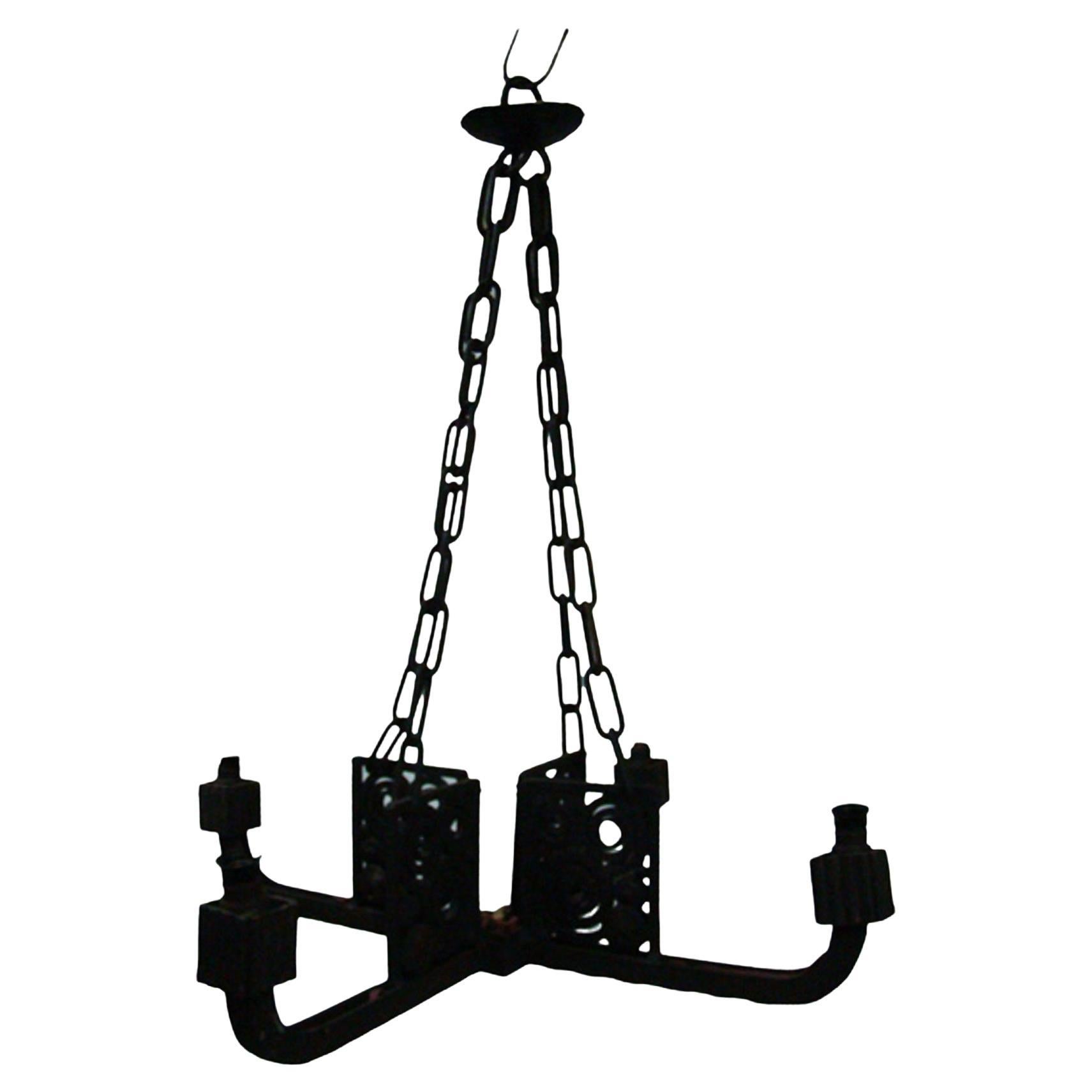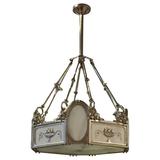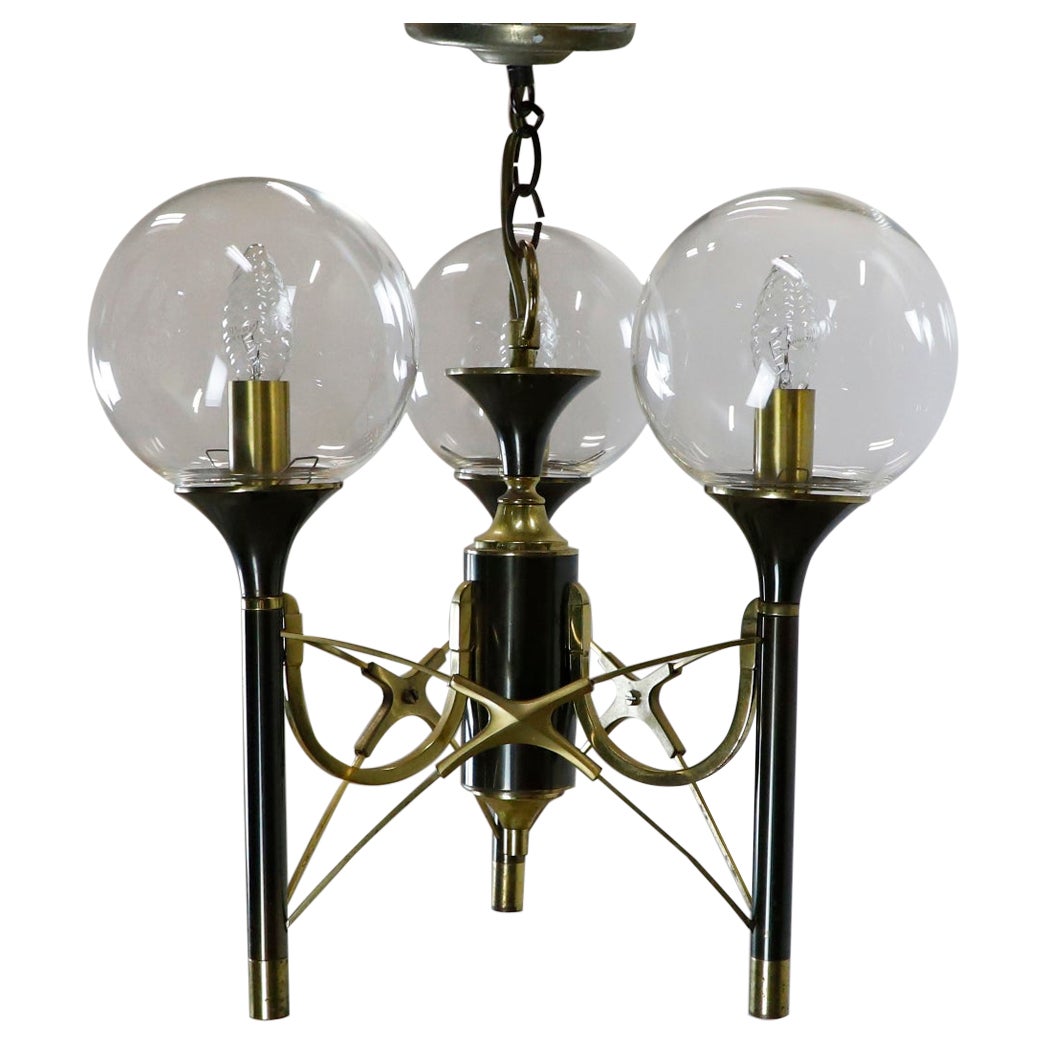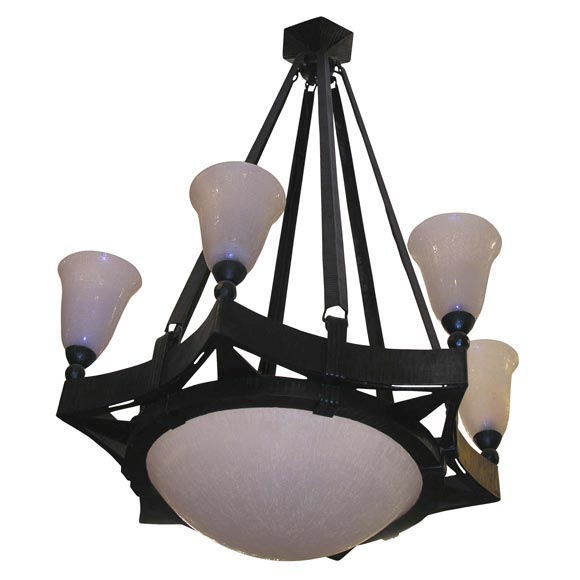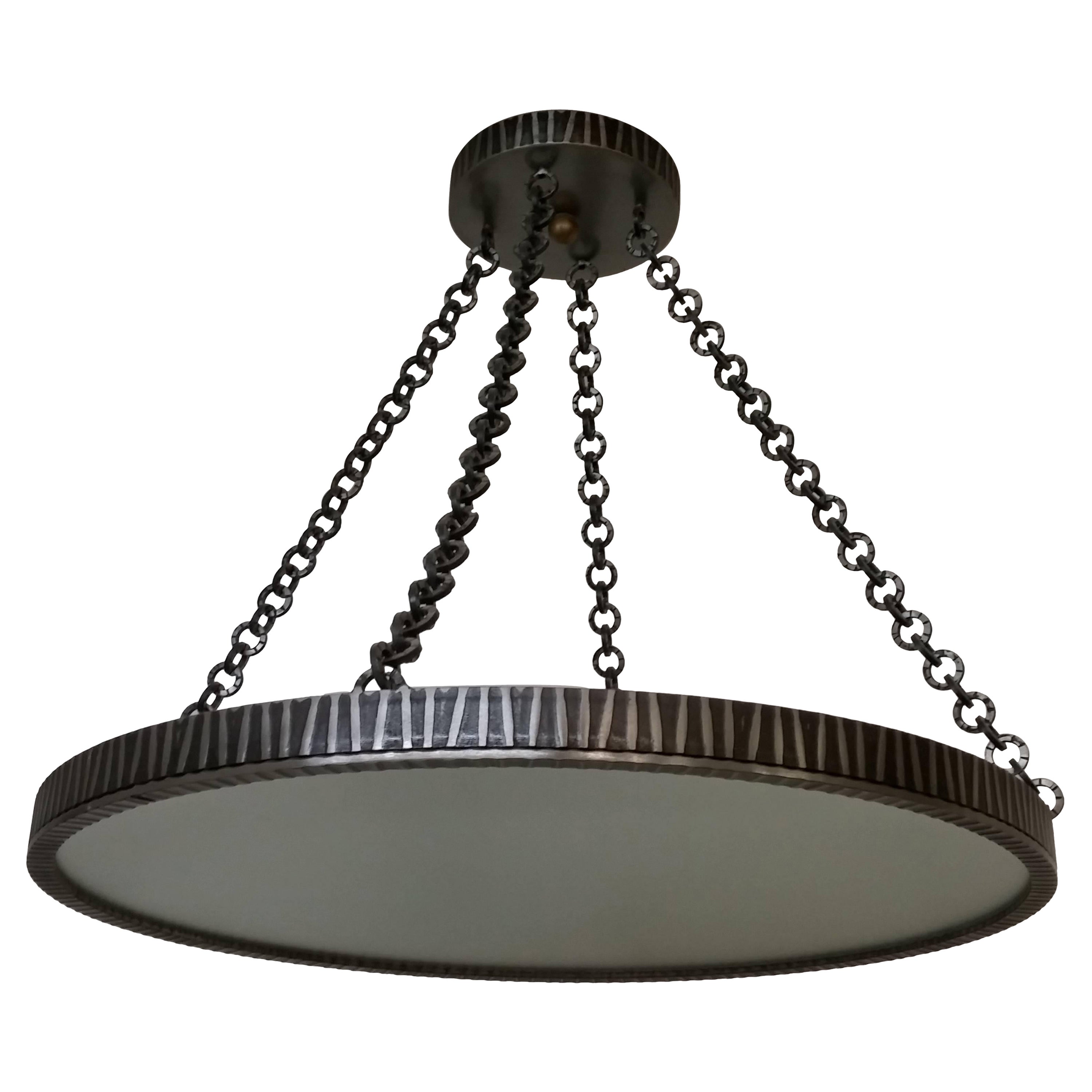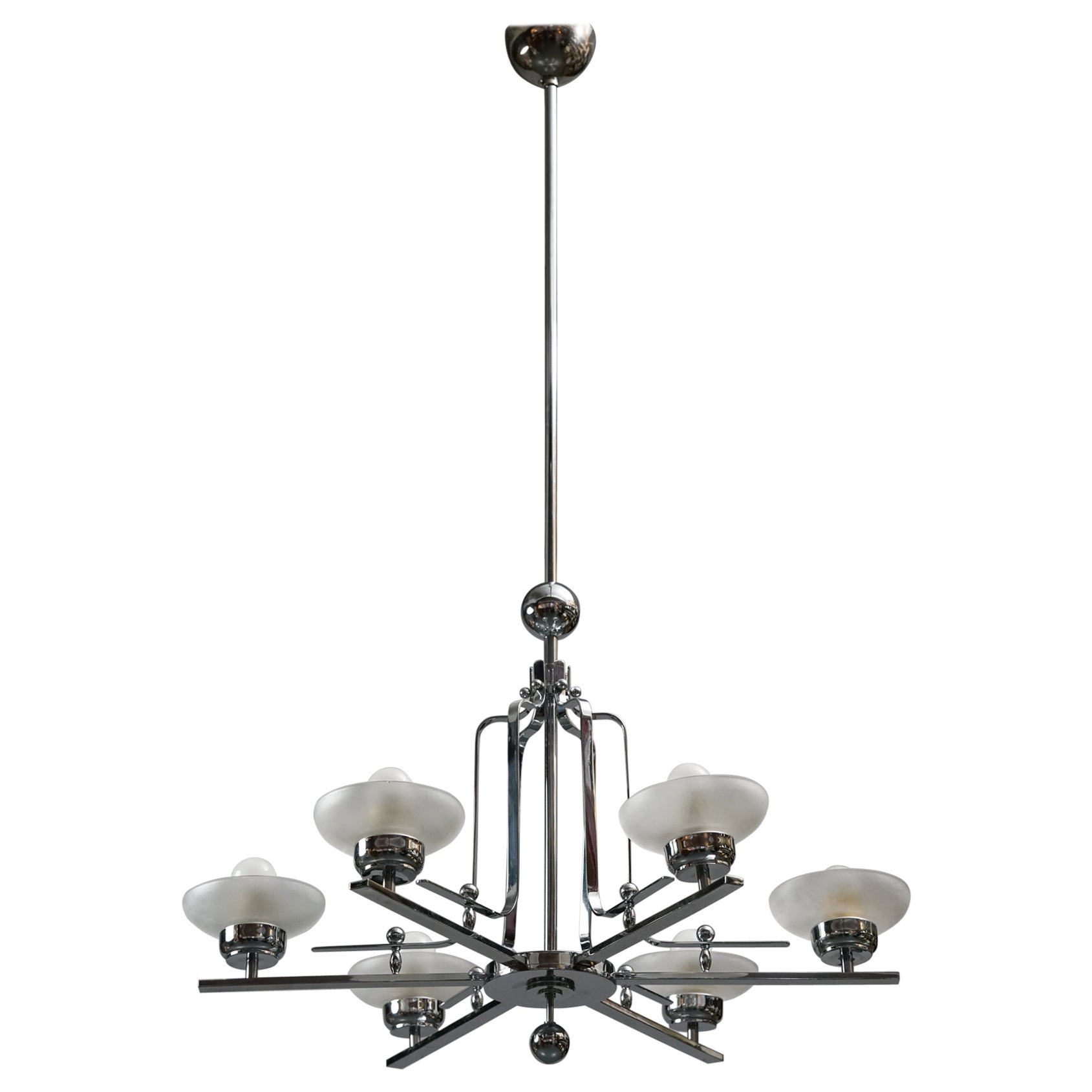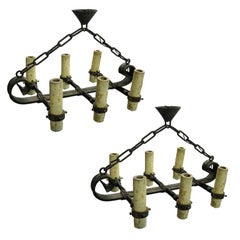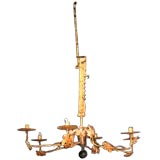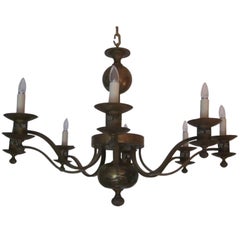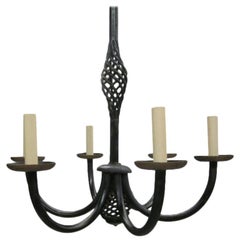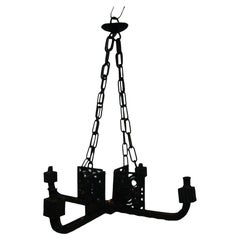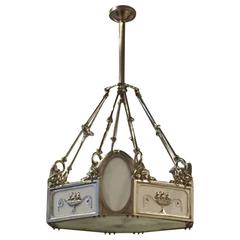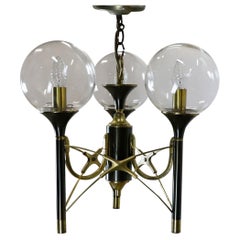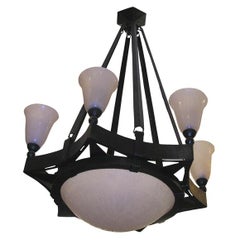Items Similar to 2 Mid-Century Modern Iron 'Star of David' Chandeliers, Raymond Subes Attributed
Want more images or videos?
Request additional images or videos from the seller
1 of 10
2 Mid-Century Modern Iron 'Star of David' Chandeliers, Raymond Subes Attributed
$2,770per item
£2,115.85per item
€2,431.35per item
CA$3,954.20per item
A$4,335.46per item
CHF 2,263.94per item
MX$52,171.86per item
NOK 28,533.42per item
SEK 26,828.75per item
DKK 18,157.66per item
Quantity
About the Item
Rare pair of French Art Deco chandeliers or pendants in hand-hammered wrought iron attributed to Raymond Subes in the form of a star. The pieces are hung from three strands of large hand-hammered chain links and suspended from a large handmade hook that will connect to a canopy. Can be electrified with six Edison or candelabra sockets. Height can be modified to suit taste.
Priced and sold individually.
- Attributed to:Raymond Subes (Metalworker)
- Dimensions:Height: 39.5 in (100.33 cm)Diameter: 33 in (83.82 cm)
- Style:Art Deco (Of the Period)
- Materials and Techniques:
- Place of Origin:
- Period:
- Date of Manufacture:circa 1930
- Condition:
- Seller Location:New York, NY
- Reference Number:Seller: sd61stDibs: LU79351016870
About the Seller
5.0
Gold Seller
Premium sellers maintaining a 4.3+ rating and 24-hour response times
Established in 1997
1stDibs seller since 2004
230 sales on 1stDibs
Typical response time: <1 hour
Associations
20th Century Specialists
- ShippingRetrieving quote...Shipping from: New York, NY
- Return Policy
Authenticity Guarantee
In the unlikely event there’s an issue with an item’s authenticity, contact us within 1 year for a full refund. DetailsMoney-Back Guarantee
If your item is not as described, is damaged in transit, or does not arrive, contact us within 7 days for a full refund. Details24-Hour Cancellation
You have a 24-hour grace period in which to reconsider your purchase, with no questions asked.Vetted Professional Sellers
Our world-class sellers must adhere to strict standards for service and quality, maintaining the integrity of our listings.Price-Match Guarantee
If you find that a seller listed the same item for a lower price elsewhere, we’ll match it.Trusted Global Delivery
Our best-in-class carrier network provides specialized shipping options worldwide, including custom delivery.More From This Seller
View All2 French 1940 Brutalist Wrought Iron Chandeliers or Pendants in Poillerat Style
By Gilbert Poillerat
Located in New York, NY
Pair of French Mid-Century Modern 1940s chandeliers or fixtures in the style of Gilbert Poillerat in wrought iron each with six wood candle form lights composed in a harmonious recta...
Category
Vintage 1940s French Mid-Century Modern Chandeliers and Pendants
Materials
Wrought Iron
6 Arm French Rustic Chandelier
Located in New York, NY
Charming Rustic French Forties Chandelier / Pendant with 6 Arms for Electric or Candle. Height is Adjustable by Crane Mechanism. The chandelier is shown with candles but is easily c...
Category
Vintage 1940s French Mid-Century Modern Chandeliers and Pendants
Classic Modern Traditional Brass Chandelier, France, 1940
Located in New York, NY
An Elegant French Mid-century brass chandelier or pendant with classic sober lines. Eight arms with wight Edison sockets. Rewired for US standards.
Height without chain and canopy i...
Category
Vintage 1940s French Mid-Century Modern Chandeliers and Pendants
Materials
Brass
French Midcentury Wrought Iron Chandelier in Style of Gilbert Poillerat, 1940
By Gilbert Poillerat
Located in New York, NY
Classic French midcentury partially gilt wrought iron chandelier in the modern neoclassical spirit with six arms. Gilding on bobeches has aged to a dark gold patina. Height is adjust...
Category
Vintage 1940s French Mid-Century Modern Chandeliers and Pendants
Materials
Wrought Iron
French 1940 Hand-Hammered Wrought Iron Chandelier in Style of Gilbert Poillerat
By Gilbert Poillerat
Located in New York, NY
Handmade French Post Art Deco wrought iron chandelier in the Brutalist tradition with six lights. The presentation of this piece is dramatic with a handmade chain link stretcher unit...
Category
Vintage 1940s French Rustic Chandeliers and Pendants
Materials
Wrought Iron
Italian Mid-Century Modern Design Double Level Chandelier in Brass & Nickel
Located in New York, NY
Original Italian Mid-Century Modern double tier chandelier in brass and nickeled metal with six lower arms and three upper arms. Each arm terminates with three stunning discs leading...
Category
Vintage 1960s Italian Mid-Century Modern Chandeliers and Pendants
Materials
Brass
$7,820 Sale Price
20% Off
You May Also Like
Chandelier Art deco, Designer: Edgard Brandt, 1920, France, material: iron
By Edgar Brandt
Located in Ciudad Autónoma Buenos Aires, C
Amaizing hanging lamp Designer: Edgard Brandt
Material: iron
Style: Art Deco
Country: France
To take care of your property and the lives of our customers, the new wiring has been done.
We have specialized in the sale of Art Deco and Art Nouveau and Vintage styles since 1982. If you have any questions we are at your disposal.
Pushing the button that reads 'View All From Seller'. And you can see more objects to the style for sale.
Why are there so many antiques in Argentina?
In the 1880 – 1940 there was a grate wave of immigration encouraged by the periods of war that were taking place.
1st World War took place between 1914 and 1918
2nd World War took place between 1939 and 1945
The immigrants options were New York or Buenos Aires. Tickets were cheap and in Buenos Aires they were welcomed with open arms, as it was a country where everything was still to be done.
Argentina was the country of new opportunities, labour was needed and religious freedom was assured, in many cases the of the family travel first until they were settled and then the rest of the family members join them.
In the immigrant museum “Ellis Island Immigrant Building” in New York you can se the promotional posters of the boats that would take them to a new life.
Between the years 1895 and 1896, Argentina had the highest DGP (gross domestic product) per capita in the world according to the Maddison Historical Statistics index, this situation arose due to the large amount of food being exported to European countries, which were at war.
The Argentinean ships left the port of Buenos Aires with food, but they returned with furniture, clothes and construction elements, (it´s common to see this the old buildings of the historic neighbourhood of San Telmo, the beams with the inscription “Made in England)”, as well as many markets that were built in Buenos Aires, such us the San Telmo Market, whose structure was brought by ship and afterwards assembled in 900 Defensa Street.
With the great influence of European immigrants living in the country, the children of the upper classes travelled to study in France, resulting in the inauguration of “La Maison Argentinienne”, on 27th of June 1928, in the international city of Paris, which hosted many Argentinians that were studying in Frace.
It´s the fourth house to be built after France, Canada and Belgium, being the first Spanish-speaking one. Still in place today (17 Bd Jourdan, 75014, Paris, France). Many of the children of these wealthy families who attended international art exhibitions, museums and art courses abroad, took a keen interest in the European style. This is why Buenos Aires was at the time referred as “The Paris of South America”.
Between the years 1890 and 1920 more than a hundred Palaces were built on Alvear Avenue the most exclusive avenue in Buenos Aires. Today some of these palaces have been transformed into museums, hotels and embassies.
In the year 1936, the Kavanagh building was inaugurated, it was the tallest reinforced concrete building in South America.
During 1994 the American Society of Civil Engineers distinguished it as an “international engineering milestone”, and it´s now considered a World Heritage of Modern Architecture.
At the time was common to hire foreign architects such as Le Corbusier, who visited Buenos Aires/Argentina in 1929 and in 1948 he drew up the blueprints for a house built in La Plata City (which was declared a World Heritage Site).
In 1947, the Hungarian architect Marcelo Breuer designed “Parador Ariston” in the seaside city of Mar del Plata. After an Argentinean student at Harvard University convinced him to come to Argentina. He worked on an urban development project in the Casa Amarilla, area of La Boca.
The Ukrainian architect, Vladimiro Acosta, arrives in Argentina in 1928 and worked as an architect until que moved to Brazil.
Antonio Bonet, a Spanish architect who worked with Le Corbusier in Paris, arrives in Argentina in 1937, where he carried out several architectural works and in 1938 designs the well-known BFK chair.
Andres Kálnay, of Hungarian origin, made around 120 architectural masterpieces, among which the former Munich brewery stands out, he even made the furniture’s design.
The German architect, Walter Gropius, director of the Bauhaus, lived in Argentina, where he wrote articles for “Sur” magazine and founded in Buenos Aires, an architectural firm with Franz Möller, who was also an architect, where he built two houses.
At the same time several famous designers decided to immigrate to Argentina, among them we can find the well-known French designer, Jean-Michel Frank, who arrived in the country in 1940 and also worked for the Rockefeller family.
Special pieces were made, which were sold exclusively in the country, such as the well-known German company “WMF”, who sold their products by catalogue, which were chosen by the ladies of high society in the list of wedding gifts, as well as the pieces designed by Christofle.
The Swiss sculptor Alberto Giacometti, made special pieces for Argentinean mansions.
In 1904 the first Jansen branch outside Paris was established in Buenos Aires, as the Argentinean clientele demanded a large amount of furniture, from the end of the 19th century to the mid-20th century.
In 1970, the brand Rigolleau Argentina made pieces authorised by Lalique.
The brands Maple and Thompson also set up shop in the country.
The French plastic artist, Marcel Duchamp moved to Argentina in 1918-1919.
Glass signed Gallé, Charder, Leverre, Schneider, Muller and other French firms. They were bought in flower shops and were given to ladies with beautiful floral arrangements.
Some furniture manufacturers travelled to international fairs and bough the patterns to produce the furniture in Argentina, such as the furniture firm Englander and Bonta, who bought the patterns ins Italy.
It is worth mentioning that in Argentina we have the largest community of Italians outside of Italy, as it is estimated that 70 percent of the inhabitants have at least one Italian descendant, followed by Spanish immigrants.
The most Important furniture stores in Argentina:
Comte is founded in 1934 (under the direct management of Jean Michel Frank in 1940).
Nordiska (Swedish company established in 1934).
Churba in 1960, a company that brought foreign designers to present their furniture in the country:
Denmark: (Arne Jacobsen, Finn Juhl, Bender Madsen, Ejner Larsen, Poul Kjaerholm, Hans Wegner)
Sweden: (Hans Agne Jakobsson, Gustavsberg)
United States: (Herman Miller)
Finland: (Lisa Johansson, Folke Arstrom, Tapio Wirkkala, Alvar Aalto, Timo Sarpaneva)
Swedish Factory: (Orrefors)
Italy: (Littala, Vico Magistretti, Emma Gismondi, Gae Aulenti, Angelo Mangiarotti, Elio Martinelli, Gianna Celada, Angelo Mangiarotti, Mario Bellini, Carlo Scarpa)
Finland: (Olivia Toikka)
Plata Lappas (Lappas Silver): a goldsmith shop founded in 1887 in Argentina by Alcibiades Lappas of Greek origin.
In 2019, in Argentina took place “the Art Deco world congress”, in which we participated as hosts invited by Geo Darder, founder of the Copperbridge – Foundation, in which prominent people from all over the world attended to learn about Art Deco in Argentina.
Argentina currently has more than 100 Art Deco buildings and another 90 Art Nouveau buildings throughout the city of Buenos Aires.
Argentina is a country that has not been involved in many wars, which is why it has been a refuge for works of art and antiques from different periods of time, unlike European countries. That is way many collectors, museums and antique dealers from all over the world visit it, you should not miss the opportunity to visit this great country.
Laura Guevara Kjuder, architect.
If you want to live in the golden years, this is the lighting that your project needs.
We have specialized in the sale of Art Deco and Art Nouveau and Vintage styles since 1982.If you have any questions we are at your disposal.
If you are looking for sconces to match your ceiling lighting, we have what you need.
Pushing the button that reads 'View All From Seller'. And you can see more objects to the style for sale.
Edgar Brandt
He was born in Paris on December 24, 1880. His family moved to Orleans when Brandt was 4 years old. At age 18, he graduated the Brevet Technicien Superieur and did two years military service with the 153rd infantry in Nancy. Brandt was awarded a gold medal 1st class, at the Salon des Artistes Francais, and became a member of the vetting team of the organization. In 1904, he was ordered to go to Toul near Nancy for military service. There it became apparent to him that the French Infantry had no light versatile weapon with a long target-range. At the end of the year he returned to Paris with the order to design and make a 60mm mortar and the required ammunition. Trained in the Ecole Professionnelle de Vierzon, he set up an ironmongery in Paris. There he created gates, balustrades, floor lamps and chandeliers in bronze, hammered wrought iron and steel for grand houses and ocean liners. His style was typical for the period with cone-fires, branches, fruits, and even birds and human faces. After the WWI, he created the Tomb of the Unknown Soldier under the Paris Arc de Triomphe. He participated in the famous Exposition Internationale des Arts Decoratifs de 1925 in Paris, making the monumental gate...
Category
Vintage 1920s French Art Deco Chandeliers and Pendants
Materials
Iron
French Art Deco Bronze Chandelier
Located in North Bergen, NJ
French Art Deco nickel-plated bronze chandelier. Having milky white glass and floral motif. Very elegant adding the perfect Deco decor to your home. Giving off beautiful amount of li...
Category
Vintage 1940s Art Deco Chandeliers and Pendants
Metal 3 Lights Chandelier
Located in Mexico City, CDMX
Circa 1980. We offer this Metal 3 Lights Chandelier. Made in metal.
Category
Vintage 1980s Mexican Mid-Century Modern Chandeliers and Pendants
Materials
Metal
French Art Deco Chandelier by Edgar Brandt and Daum
By Edgar Brandt
Located in Bridgewater, CT
Wrought iron chandelier by Brandt, frosted glass shades by Daum, signed.
Category
Vintage 1930s French Art Deco Chandeliers and Pendants
Materials
Wrought Iron
Modern Worout Iron Chandelier
Located in Long Island City, NY
A large hand-forged wrought iron chandelier decorated with textures motif designs (36 inches in diameter, height adjustable) Links can be replaced with rods. Plating in different fin...
Category
Vintage 1980s Art Deco Chandeliers and Pendants
Materials
Wrought Iron
Paavo Tynell Style Rare Chandelier, Early 1900s
By Paavo Tynell
Located in Helsinki, Uusimaa
Paavo Tynell style rare chandelier from the early 1900s. Chromed metal frame with milk glass shades. Good vintage condition, minor wear and patina consistent with age and use. Beauti...
Category
Early 20th Century Finnish Art Deco Chandeliers and Pendants
Materials
Chrome
More Ways To Browse
Large Mid Century Black Chandelier
Pair Art Deco Chandeliers
1930 Chandelier Black
Art Deco Star Of David
Art Deco Star Chandelier
Star Of David Furniture
Danish Modern Office Furniture
French Antique Lighting
Ceiling Lighting
Murano Italian Chandelier
Italian Murano Pendant
Mid Century Glass With Gold
Mid Century Modern Ceiling Lighting
Antique Crystal
1950s Italian Furniture
Mid Century Modern Light Fixtures
Vintage Screwing
1930s Living Room Furniture
